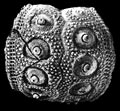The Echinoid Directory
Delocidaris Philip, 1964, p. 464
| Diagnostic Features |
|
|---|---|
| Distribution | Miocene, Australia. |
| Name gender | feminine |
| Type | Goniocidaris prunispinosa Chapman & Cudmore, 1928, p. 90, by original designation. |
| Species Included |
|
| Classification and/or Status |
|
| Remarks |
|


